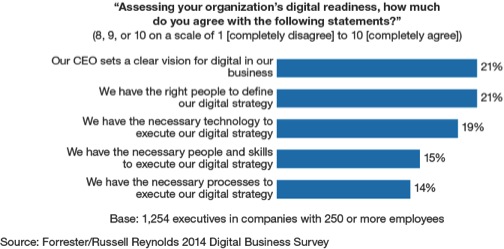By adaptive - March 12th, 2014
Every business needs to look forward with its social media usage, but what does the future hold across these networks, and how can corporations leverage these changes?
Anyone that attended the Social Media Week event last month will have come away with their heads buzzing with the possibilities that social media has yet to deliver. What is clear for all corporations is that their businesses must become social enterprises if they are to survive long term, and continue to connect with their customers who are increasingly using social media as a benchmark for brand advocacy, positive sentiment and where they want to spend on goods and services.
One of the clear messages that came out of the event was that original and well-designed content is important, but this must also be targeted to the right groups, as a broadcast of this content won’t be effective. Social media, and the analytical platforms that are now available, allow a level of insight that is unprecedented. This offers corporations a chance to focus on what can sometimes be small groups, but who can be highly lucrative. Also, it seems that content can also be detailed and offer deep insight into a topic – something that Millennials or Gen Y audiences relish according to Markham Nolan, Managing Editor of the Gen Y global social news network Vocativ.com.
The messages that came through loud and clear from the week of events mean that corporations must do more to ensure they are embracing all forms of digital media to ensure their marketing messages are received. The drive to place social media at the heart of these messages is a fundamental component of today’s digitally aware enterprises.
In their latest research Forrester states: “Business leaders don't think of digital as central to their business because in the past, it hasn't been. But now your customers, your products, your business operations, and your competitors are fundamentally digital. While 74% of business executives say their company has a digital strategy, only 15% believe that their company has the skills and capabilities to execute on that strategy.”

“For the past few years, companies have been bolting “digital” onto their existing business like teens paint go-fast stripes onto their cars. “Look, we’re digital” is the message CEOs want to send to investors,” Forrester continues. “But the piecemeal strategy of bolting digital channels or methods onto the business is no longer sufficient. Instead, you must think of your company as part of a dynamic ecosystem of value that connects digital resources inside and outside the company to create value for customers. To do this, you must fully harness digital technologies, both to deliver a superior customer experience and to drive the agility and operational efficiency you need to stay competitive.”
Corporations of course also have to show ROI, which has been somewhat of a bugbear since the inception of social media. Where clear ROI was possible to show after traditional ad spends, social media is much more subtle, and has what could be described as ‘soft ROI’ that has many more factors to consider – many of which do not result in a monetary value being placed on a piece of social media activity.
ROI is also moving onto mobile devices, as social media access also goes on the move. Consumers with access to the latest mobile communications devices are using these platforms to manage their social media networks, which include the relationships they have with brands.
All corporations must pay attention to this shift in how these connections are made, and which mobile devices are favoured. There is also the issue of that has become known as ‘dark sharing’ after the acquisition of WhatsApp by Facebook. Here, private messaging within highly specific groups could replace the more open platforms such as Facebook and Google+ There hasn’t been a wholesale shift yet, but as privacy becomes more important, keeping a close eye on how consumers share content and with whom is a key marketing metric to track and understand.
What Social Media Week showed is that this sector is a shifting channel that won’t allow any business to be complacent. Understanding what content is shared – video continues to be the most popular by some margin – but also the changing attitudes to social media usage are important aspects of all corporate social media to thoroughly appreciate and understand.
Leadtail summarised the current state of play in their report that focuses on how CFOs use social media: “As social media continues to reshape how we communicate, brands and vendors must increasingly become more like publishers – creating and sharing high quality, highly relevant content on a regular basis – or risk losing out to competitors that do.”
Corporations must develop their digital channels into much more than simply additions to their traditional marketing activity. The social and digitally adept business will become leaders in their market sectors, but above all else, coveted by their consumers.
Next Reads
November 2014, New York
The Social Media for Customer Service Summit is your one-stop-shop for all the latest social media insight and best practice. It gives you a 360 degree look into building, operationalizing and initiating a successful social media strategy at your company
Brochure Programme